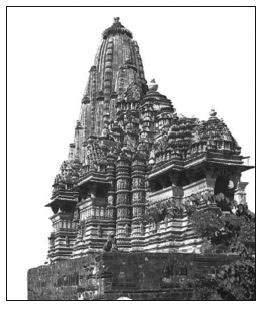Question 1:
How is the “trabeate” principle of architecture different from the “arcuate”?
Answer:
Trabeate is a style of architecture in which roofs, doors and windows are made by keeping a horizontal beam across two vertical columns. Arcuate is an architectural form in which the weight of the superstructure is borne by the arches.
Question 2:
What is a Shikhara?
Answer:
Shikhara is the top tower of any temple.
Question 3:
What is pietra-dura?
Answer:
Pietra dura is a term for the inlay technique of using colored stones that are cut, fitted and polished for creating beautiful and decorative images.
Question 4:
What are the elements of a Mughal chahar bagh garden?
Answer:
Chahar bagh garden is a group of four gardens or a formal garden which was made inside four walls in the form of a rectangular shape. They were divided by artificial channels into four quarters.
Question 5:
How did a temple communicate the importance of a king?
Answer:
The temples and mosques communicated the importance of a king. It was so because they were not only places of worship but also these temples and mosques showed the power, wealth and devotion of the patron or king. By building these structures, kings represented their nearness to gods and wanted to created their image as god’s representatives on earth in the eyes of their subjects. This was done by the kings to gain respect and devotion as given to gods.
Question 6:
An inscription in Shah Jahan’s diwan-i-khas in Delhi stated, “If there is Paradise on Earth, it is here, it is here, it is here.” How was this image created?
Answer:
These words were said by Shah Jahan about the beauty of Kashmir. Once Shah Jahan went over there and he was amazed to look at the beauty of Kashmir. Then he spoke these words. It actually tells us about the beauty of architectural buildings which were made during Shah Jahan’s reign.
Question 7:
How did the Mughal court suggest that everyone–the rich and the poor, the powerful and the weak–received justice equally from the emperor?
Answer:
Most of the Mughal kings were fond of making buildings of historical importance. For this, Shah Jahan made many buildings and the connection between king’s justice and court was highlighted by the newly-constructed court in Delhi’s Red Fort. The audience hall constructed there was made to communicate justice to the people in a way that all will be treated as equals without any prejudice by the king. This would, in turn, create an environment of harmony and peace.
Question 8:
What role did the Yamuna play in the layout of the new Mughal city at Shahjahanabad?
Answer:
Yamuna played an important role in the layout of the new Mughal city at Shahjahanabad. It was built in such a way that nobles had an easy access to the river. The command of the river front was in the hands of the imperial palace. Only the favoured nobles were given access to the river, especially the eldest son of Shah Jahan—Dara Shukoh. All the other people were required to build their homes in a distance from the river.
Question 9:
How could the Rajarajeshvara temple at Thanjavur be constructed faster today?
Answer:
This Rajarajeshvara Temple of Thanjavur which was made by King Rajarajadeva in the honour of
the deity, Rajarajeshvaram. It took a long time in the construction of this temple. This
type of temple can be constructed very quickly in modern age due to following reasons:
(i) In earlier times, there were no architects to make a plan for the construction with
which it can be built very quickly. A map or a plan can help a lot in making any building
easily.
(ii) This temple is made up of several big stones and some of them weighed around 90 tonnes.
These stones were lifted to the shikhara manually, which took a long time and a lot of
labour force to lift. But today, heavy machines and cranes are available which could lift
such heavy stones very easily.
(iii) In earlier times, people used to carve the stones manually which was a very
time-consuming job but today, machines for carving the stones are also available.

Question 10:
What differences do you notice between the shikharas of the two temples? Can you make out that the shikhara of the Rajarajeshwara temple is twice as high as that of the Kandariya Mahadeva?
Answer:
The shikhara of the Rajarajeshwara temple is bigger than that of Kandariya Mahadeva temple. The main shikhara is 31 m high, whereas that of Rajarajeshwara temple is more than 62 m high.
Question 11:
Describe what the labourers are doing, the tools shown, and the means of carrying stones.
Answer:
The workers are constructing the water-gate at the Agra Fort. The workers used simple tools and implements as well as basic materials of masonry. Stones were carried through oxen to the construction-sites.
Question 12:
In what ways do you think the policies of Rajendra I and Mahmud of Ghazni were a product of their times? How were the actions of the two rulers different?
Answer:
Kings built temples to demonstrate their devotion to God as well as their power and wealth. Therefore, it is normal to perceive that, at the time of invasion or attack, they targeted these buildings. The Chola king, Rajendra I, built a Shiva temple in early eleventh century and kept there many valuable statues that were plundered from the kings he had defeated. Similarly, Sultan Mahmud of Ghazni, during his campaigns in India, looted the wealth and idols from many temples. Although, he was not an important figure at that time, he became a great hero of Islam after destroying famous temples such as the Somnath Temple.
